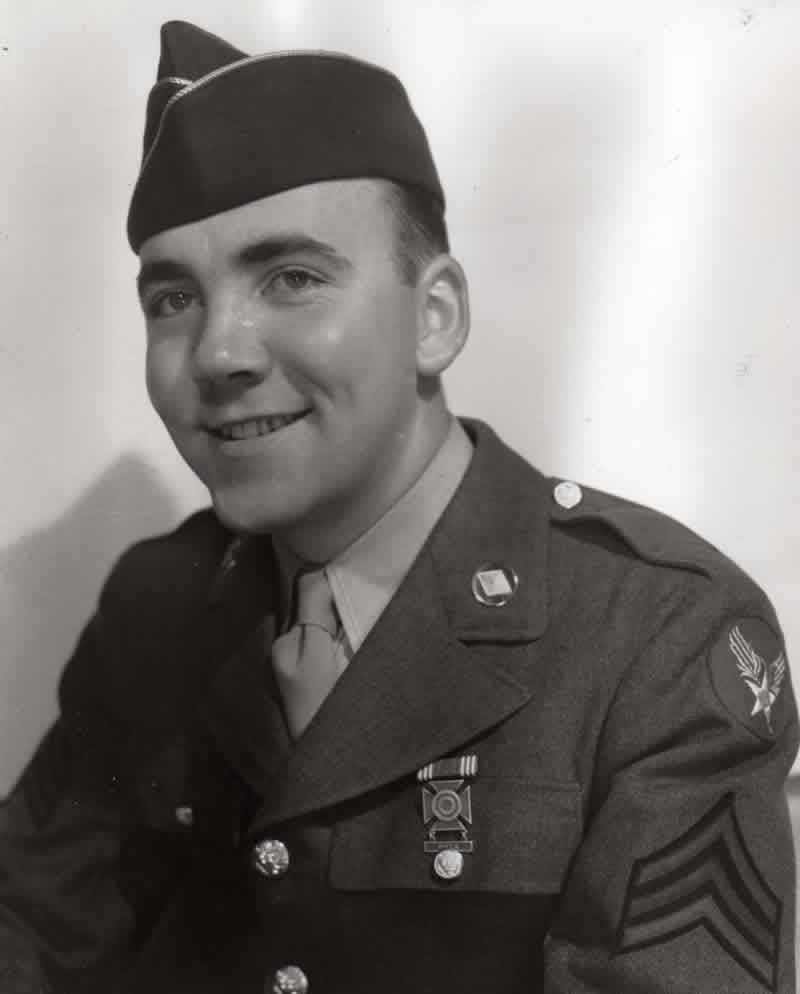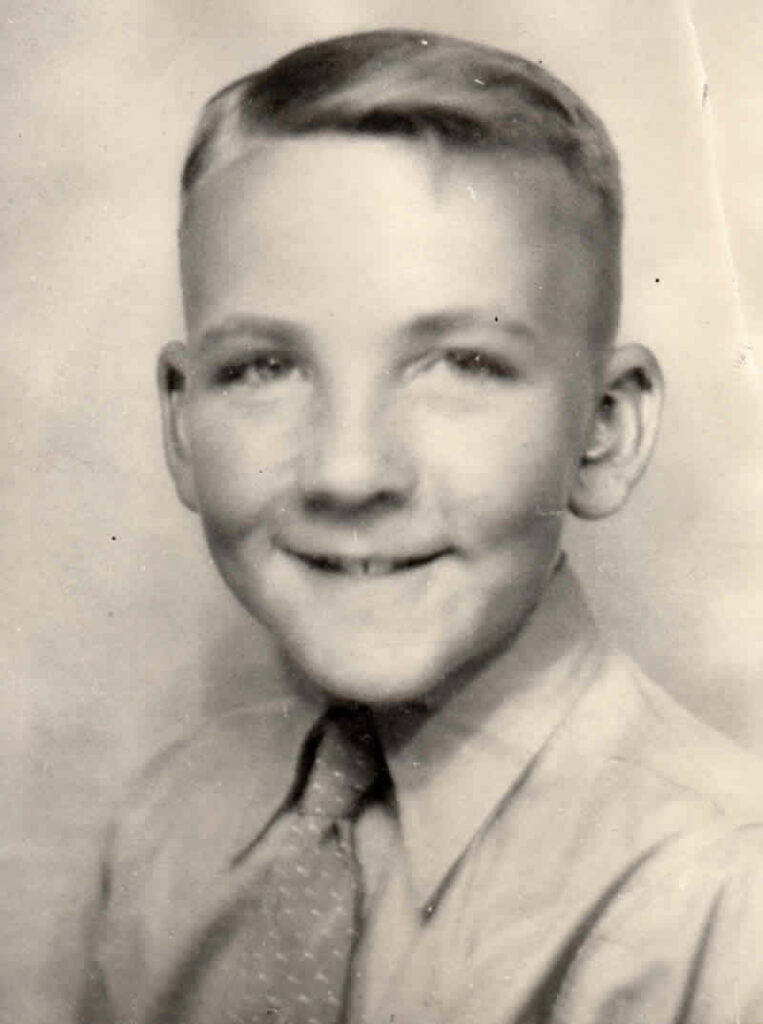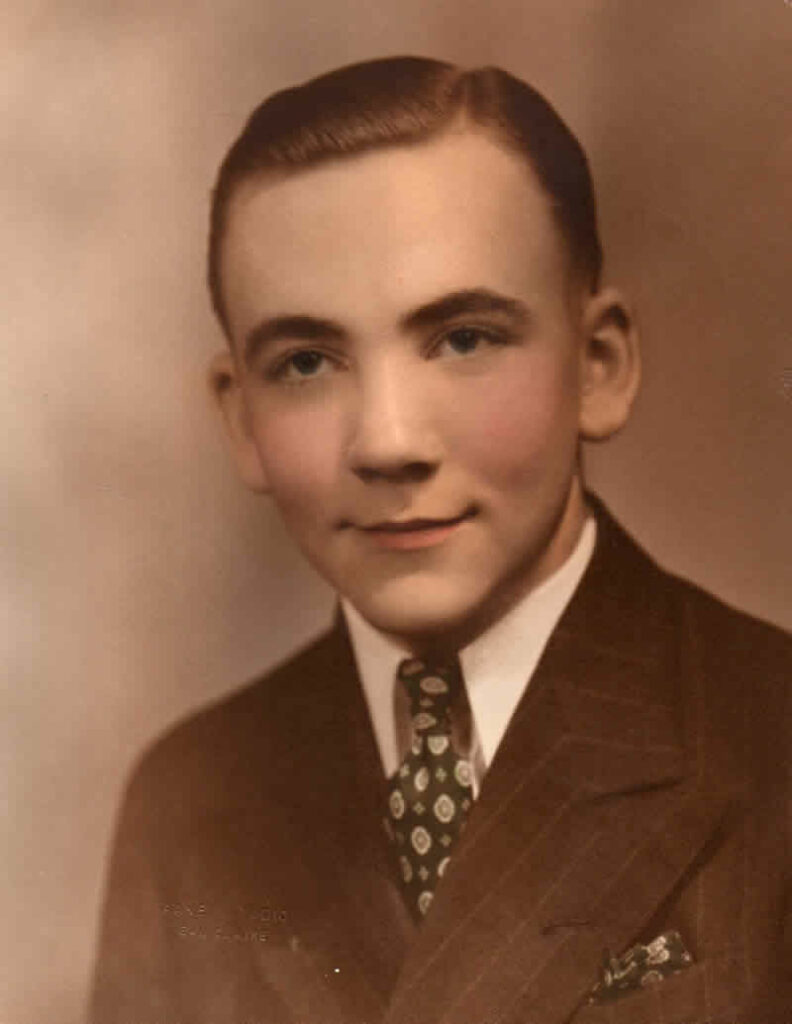After the attack on Pearl Harbor by the Japanese on December 7, 1941, the Country began mobilizing for War almost immediately. It was a very unsettled time, especially for those who would be entering military service. I had been working in the office of the New York Life Insurance Company since April of 1941. I had performed accounting functions and learned general office procedures, which I believed, helped me get into the army finance department.
During the summer of 1942, I knew my draft number would be coming up quite soon and was debating whether or not I should enlist or wait to be drafted and hope to get into ta branch of the service that I preferred. The Army Air Force seemed very attractive in those days but finally decided to wait and be drafted.
I received my “Greetings” letter telling me to report for my physical in Milwaukee. That was quite an experience. We traveled by bus and stayed at the Plankinton House. The place of examination was in a large old warehouse. I had never been in a place with so many men all bare naked before. Well, I passed with flying colors and was inducted into the army on 17 October 1942 and was to report for active duty on 31 October 1942.
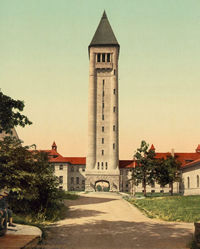
Read More
On that date we traveled by rail on the Chicago Northwester’s “400” to Fort Sheridan, Illinois, which was just north of Chicago. In those days the “400” had some special red, white and blue cars that were reserved for army inductees. The train was named the “400” because it traveled from Minneapolis to Chicago, 400 miles in 400 minutes.
Arriving at Fort Sheridan late in the evening we were assigned to barracks and would begin processing early the next morning. The army serial number assigned to me was 36 275 650. I don’t think I will ever forget that number since it had to be on all of our clothes and equipment.
For the next several days we were issued clothing and had many shots and took several aptitude tests. Inductees began shipping out to camps all over the United States. In the meantime we weren’t just sitting around. I remember I was assigned to KP the first three nights from 7:30pm to 1:30am peeling potatoes and carrots. I began to wonder if I had made a bad mistake. Nearly all of our group had shipped out and there were just six of us left. Finally, our orders came and we were assigned to Fort Benjamin Harrison, Indiana. It was just outside of Indianapolis. Someone said it was a Cook’s and Baker’s school, but we soon learned it was the Finance Department Replacement Training Center for the whole Army. At that point all six of us were quite happy.
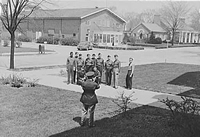
Read More
Fort Benjamin Harrison was an old regular army base. Most of the buildings were brick and many beautiful homes were built around the parade grounds where the officers and their families lived.
The program at Fort Ben was four weeks of intensive basic infantry training and followed by eight weeks of finance school learning how to prepare payrolls and other financial matters as well as studying army regulations.
Our basic infantry training was very strenuous. We went on several fifteen-mile hikes and over many obstacle courses. It was November and quite cold and snowy in Indiana. At the beginning of basic training we were all pretty much a bunch of softies, by the end of the four weeks we had already begun to shape up. Each of us was assigned his own gun. Mine was an Enfield, 30 caliber. It was very heavy but also very accurate. I qualified as a sharpshooter and was given a $2.00 check from the Company Commander. I forgot to salute him when he handed me the check, my buddies reminded me though.
The officers and men who trained us in basic were all regular army cadre. They were tough as nails and could do everything that we couldn’t.
After our four weeks of basic infantry training, we started finance school. We were required to be dressed up for school, wool pants and shirt, tie and field jacket if necessary. We arose at 4:45am, shaved, made our beds (no wrinkles), cleaned the barracks and marched to school, in formation, by 8am. We marched back to the barracks for noon dinner and then back to school by 1pm. Back to the barracks at 5pm, have supper and then march to school for a 7:00 – 9:00 period. At the end of the day we were pretty tired.
Everything at Fort Ben was done in the old military fashion. We marched into the mess hall and stood by our places until the First Sergeant came in and shouted “SIT.” The food was generally good and was served family-style.

We usually could get a day pass to go into Indianapolis for a movie on Sundays. In the center of downtown Indianapolis was an area known as the “Circle.” The big Circle Theater was located in this area and we would see all first run movies there as well as a stage show featuring big name bands. I remember seeing such big bands as Charley Barnett and Henry Busse.
After finishing school in February of 1943, we were placed in 15 man units and shipped to various army bases for actual experience of working in finances offices. On the day we shipped out from Fort Ben, the snow was knee-deep. Our group was assigned to Dale Mabry Field in Tallahassee, Florida. At Dale Mabry Field, we did a lot more studying and also close order drill to keep us in shape. Our first furloughs were coming up and everyone was excited about that. It was the first time we would had been home since induction. We worked out a system whereby we would get a one-day pass and then a ten-day furlough. I remember I got to Flomaton, Alabama before my furlough even started. I arrived in Eau Claire a day before I had told my folks I would be there. They were quite surprised and hardly recognized me since I had gained so much weight. At the time I was inducted I weighed 117 pounds and now I weighed 152.
After returning to Tallahassee, my outfit had moved over to Key Field in Meridian, Mississippi. Also, a few in our group had gotten the chicken pox and could not travel until they were well.
On the trip to Key Field, Alan Jones, the singer, and Harry Blackstone, the magician, were on the train. We got their autographs but I must have lost them.
Being stationed at Key Field was almost like working in a civilian office. Our barracks were across the street from the finances office. We reported for work at 8am and quit work at 5pm. We never had any drill or other duties. I always thought that there were a lot of politics going on at that field. One fellow in the office got a brand new Plymouth and took time off to drive it back from Detroit. Another fellow owned a dry cleaning business in Meridian and would work at the base during the day and work at the business in the evening and also live at home.
After working at that office for about 2 months, we were transferred to Seymour Johnson Field in Florence, South Carolina. This was the poorest place where we were stationed. We lived in tents with wooden floors. The rats had a ball under the floor. While stationed there, we got a three-day pass and Henry Williamson, a buddy of mine, and I went up to Washington, D.C. Later on we got another furlough and went home. This was sort of standard procedure before transferring overseas.

Read More
In December, 1943, we were shipped up to Camp Kilmer, N.J. to be outfitted for travel overseas. We got all new clothing, shots, haircuts etc. and were supposed to have a three-day pass in New York for Christmas. Instead, on December 22, 1943, we got on the Queen Mary and sailed out of New York harbor on December 23, 1943. I have a book that I purchased on the Queen Mary after it was permanently moored in Long Beach, California. Our sailing was known as WW #30 E, New York-Gourock, 12/23/43, Captain Bisset, with 11,990 troops and a crew of 1,087. We traveled 3,662 miles in 5 days, 10 hours and 30 minutes. Our average speed was 28.06 knots. Since we traveled so fast we did not have a convoy. The Atlantic was very rough during the middle of winter and most of us were seasick. We had two meals a day, 10am and 4pm. The food was terrible and I existed mainly on dry bread. The crew, of course, was English.
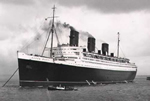
The ship was beautiful, the state rooms we stayed in had been converted to bunks on the wall, approximately 12 men to a room. We could stay in the staterooms for 8 hours and then get up on the deck for 16 hours. Gambling was rampant aboard ship. I’m sure that a lot of men were thousands of dollars richer, or poorer, when we arrived at our destination. No dogs were allowed on ship, however, the second day out we saw quite a few dogs. The GI’s had smuggled them aboard in their duffel bags. We had announcements every morning. The Captain said to stay away from the ships rail since we make no stops. Sometime during the war, the Queen Mary hit one of our own ships and broke it in two. I heard they never stopped and that all were lost on the smaller ship. I can safely say that those 5 days on ship were some of the worst days of my life.

Read More
We landed in Grenoch, Scotland on the 29th of December, 1943. Trains were waiting for us and we traveled down to Braintree, England. We stayed there for a couple of weeks and then our 15 man unit was split up and 5 of us went up to Saffron-Walden to service another base there. The finance office was located in part of a large Quonset building. We were there for approximately 9 months and paid all of the officers and men on the base. All payments were made in cash. First, we would compute the payrolls in dollars and cents and then convert to the currency of that nation. We would make up change lists for the exact number of notes and coins required. There was usually a convoy of military police that led us into town and one following us all heavily armed. The MP’s would spread out around the bank while we went inside the bank and counted all the money. It was put into burlap bags and it was all two men could do to lift one bag. This was especially true in England where there were so many coins.
On the day we landed in England, we were welcomed by Lord Haw-Haw, the propaganda chief of the Germans. He even named our outfit.
Blackout conditions were followed very strictly. Being in January, it was very difficult to determine the skyline. Guys would go out to the latrine at night and get lost coming back. The weather was very damp and cold. In our quonset huts we had very small stoves in which we burned coke. That’s coal with the gas burned off it. It would be red hot when we went to bed but would be out when we got up in the morning and very cold.
There were several air-raid warnings at night. When we first got to England we would rush out to the air-raid shelter as soon as the alarm went off. Later, however, we wouldn’t even get out of bed. Most of the raids were over the big cities and industrial areas. I remember one night during a raid quite close to our field a British plane was shooting a German plane, you could hear the machine gun blasts and soon afterward the German plane crashed in a big ball of fire.

Read More
Our base was made up of A-20 Twin engine attack bombers produced by Douglas Aircraft Corporation. After a rather short period, the A-20’s were replaced with a more modern plane known as the A-26. It also was a light attack bomber produced by Douglas. It was getting into late May, 1944 and everyone was expecting the invasion of the Continent. During the night of June 5th, 1944, all allied planes had huge black and white checkerboards painted on their wings. During the invasion, there were so many planes in the air that the pilots would look for the checkerboards to determine if they were friend or enemy.
On the morning of the invasion, June 6, 1944, the Colonel who headed up our base came into our finance office to listen to our little radio to hear the first reports over the armed forces network. Communications sure have changed. Our planes were very busy hitting bridges, railroads and other strategic targets.
The food was not good in England. We had a lot of pork and it was very greasy and poorly prepared.

The village of Saffron-Walden was about 17 miles from Cambridge and 40 miles north of London. We would get passes to go to Cambridge and London. The first time I went to London, I stayed at the Red Cross Club. The beds were only 25 cents. We had a good tour of London. I remember the Editor of the “Daily Express” took us through that facility. It was a very interesting experience seeing London. At night, the older people would come down into the subways with their blankets and bolsters and spend the night there. London had a good subway system and you could travel all over the city very quickly.
When we would go to Cambridge, we would rent “punts” and travel all around through their canals. Britain endured extreme hardships and tremendous loss of life.
Some of the GI’s bought their bicycles. They would bike into the local pubs during the evening for a few “Mild and Bitters.” They would even paint little mugs on their bikes to show how many missions they made.
There is a large American cemetery near Cambridge where I am sure a lot of the crews from our field are buried. During some missions where the flak was very heavy, the men would get hit by flak and bleed to death before they returned to base.
There was always a lot of competition between Bomber and Fighter pilots. I remember one evening our planes were taking off on a mission and a Fighter Pilot came down and buzzed our field. His wing was so low that he hit the tail of one of our planes and immediately crashed into the ground. Needless to say, he was killed instantly. Our plane crashed and a woman living in a nearby farm house came running up to the plane just at that time all of the bombs exploded and she was killed as well as our crew.
The first month in England was probably the worst. We had no hot water so our last shower in the States was about December 23rd and our first one in England was January 31st. We didn’t smell too good. Also, our mail didn’t catch up with us for at least a month.
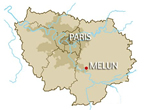
Read More
As the war progressed, our planes had to fly farther into Europe to reach their targets so on September 15, 1944, we moved down to the Port of South Hampton in order to cross the English Channel to France. We boarded a ship there and landed at Utah Beach in France. We marched 8 miles to an airfield and boarded a DC-3 and flew to Melun, France. We were stationed in an old French Chateau that had been previously used by the Germans. We were given a divided room to work out of. The front half was our office and the back half our sleeping quarters.
Since we were now in France, we were using French Francs. We used the old French currency but also used the new French invasion money. These were all paper notes printed by the American Bank Note Company. A that time, there came to be a quite a bit of counterfeiting taking place. A 1,000 Franc note was equivalent to approximately twenty dollars. If a GI came in the office and wanted to send twenty dollars home and gave you a counterfeit bill, we had to confiscate it and turn it into the Central Disbursing Office in Paris. Naturally, the GI wasn’t too happy.
At our parent office where the other 10 members of our group were stationed, there was always a “Charge of Quarters” who would sleep in the Finance Office and acted as a guard. It so happened that one night the one in charge was in the habit of smoking in bed. The office caught fire and $300,000.00 of invasion money burned up. Our Senior Officer was charged with that money and the U.S. Congress had to write it off after the war.

I remember being in Paris around Christmas time, 1944. It was at the end of the Battle of the Bulge. Hitler had set as his goal to be back in Paris by Christmas. There were many roadblocks set up since the Germans were reportedly infiltrating back through the American lines. They would wear American uniforms to try and fool the guards. The American would ask such questions as who won the World Series last year to determine if they were Germans.
I got to see a lot of Paris, a beautiful city. I saw the “Follies Bergere” while I was there.
Later in the spring, our 5-man group was shipped up to Laon, France. It was about 30 miles from the Belgian border. There we lived in barracks formerly occupied by the Germans. Our Finance Office was on the third floor of an old French Chateau. The Catholic Chaplain, Father Paul J. Cuddy, became a good friend of ours. One of my buddies, Ed Houlihan from Evanston, IL was a good Catholic and in the evenings we would play cards together with the Chaplain. This field became a rendezvous where planes would circle to get into position before striking out to Germany for some of the horrendous last bombing missions of the war in Europe. There would be as many as 5,000 planes gathering before heading for Germany. I remember two planes got in the airstream of each other and came crashing down. Some parachutes came out but others were killed.
We would get a pass occasionally to go to Paris. We would take an electric train that was very fast. We would pass through Soisons, France were there was a large American hospital. I remember standing at the railroad station in Laon to go to Paris when a long train of German prisoners, approximately 3,400, came back from the front. Many were injured. It was a site to behold.
As the war in Europe ended on May 8, 1945, we were told that we would be moving back to an area near Rheims and sailing from the Port of LaHavre, France back to the USA. After a 30-day leave at home, we would be heading for Japan.
The staging areas where we were being processed for the trip back to the USA were named after cigarettes. One was Camp Lucky Strike, another Twenty Grand Etc. Some of the GI’s that had been at the front came back with lots of German Luger pistols, German Cameras and other confiscated merchandise.
We received new clothing, shoes, and whatever we needed to return to the US. We left LeHavre, France on July 11, 1945 and arrived back in the US at Newport, News, Virginia on July 19, 1945. We were on the Grace Lines ship called Santa Rosa.
There were 400 of us able-bodied men and 800 hospital troops. The trip was very smooth, only giant swells. I was sick only one day. The cooks were all Chinese and they would stuff oranges and apples in our pockets as we went down the chow line. We hadn’t had fresh fruit for 19 months. I remember the roof of the ship opened and you could look right out at the sky. We were all very happy to be going home.
Upon landing, we were taken to Camp Patrick Henry and fed a big steak dinner. We received a 30-day furlough and were to report back to the army facility nearest to our home. That is Camp McCoy for me. Fortunately, the war in Japan ended while I was home on furlough. I did not have sufficient points for discharge, so I was shipped out to Westover Field near Springfield, Massachusetts and worked in the Finance Office there until I was discharged. The Finance Officer wanted to hire me as a civilian, but I wanted out.
I was discharged on November 9, 1945. Happy Day!
While I would not want to repeat that time, I feel I gained a wealth of experience and met a lot of fine men and learned how to get along with all kinds of people. Through all my travels in the US and Europe, my horizons were certainly broadened. I will always be thankful for being assigned to the Air Force and more specifically to the Finance Department. I also feel that I was probably one of those whose life was spared by the use of the Atom Bomb.
The people on the home front did a tremendous job supporting all the troops while suffering a lot. While I did not know Mom during the war, I am very proud of her as being classified “Essential” for being a head nurse at Luther Hospital.
I am thankful to God for his guidance through these war years and permitting me to go on and have the most wonderful wife and family in the world.

